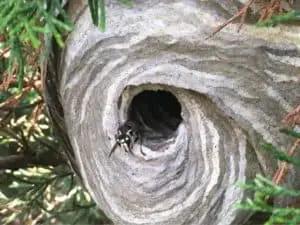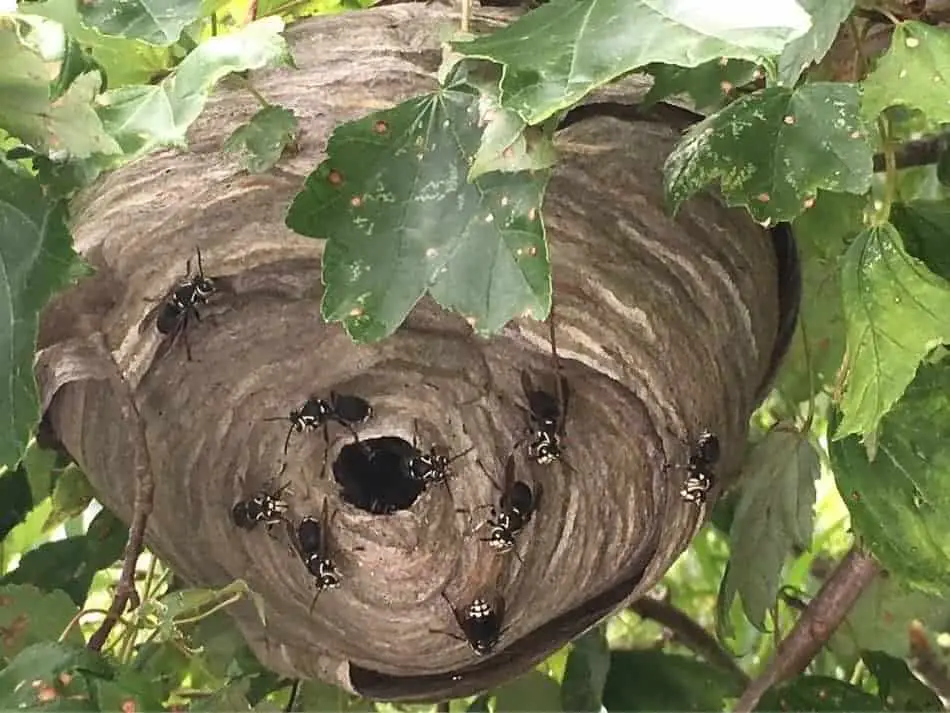I was amazed when I found out how these nests are made, they are beautiful to look at.
So how do bald-faced hornets make their nest? Since most of the foragers die in the winter it is now up to the queen to make a nest after overwintering. The queen uses cellulose and saliva to make her paper nest chewing the cellulose from dead rotting trees and other wood. The process takes 2-3 weeks.
Bald-Faced Hornet Description:
Bald-faced hornets are related more to yellow jackets than actual hornets. They are black in color with white spots on their abdomen, white lines on their thorax and a white face, which is where they get their other name white-faced hornet. Bald-faced hornets are a lot larger than yellow jackets, the workers can become over 20mm long.
What Do Bald-Faced Hornets Do?
The queen will build storage combs in the bottom half of the nest and put eggs in them. After the larvae hatch the queen will feed them until their comb is full. The larvae then make a white silky cover, then the metamorphosis happens and the Hornets come out as adults. Once born the new Hornets will assume different responsibilities, some will forage for food and help feed new larvae, some will protect the nest and others will take over the responsibility of building the nest larger. The nest by the end of summer can get up to 700 hornets strong.
Only female bald-faced hornets are around at this time. The males come later in the summer from unfertilized combs. Males are called drones they have no sting ability and are only useful in the reproduction process.
Where Do Bald Faced Hornets Make Their Nest?
Bald-faced hornets will make their nest off the ground(unless it has been knocked down). The nest will usually be built anywhere from 3-60ft high. You can find them hanging on the eaves of homes high up in a tree you can find them in bushes as well. I have personally seen one that was connected to a hose reel barely off the ground,however, a lot of times these hornet nests can go unnoticed because of how high they are in trees.
Are Bald Faced Hornets Aggressive?
Bald-faced hornets are very aggressive, they will defend their nest of any threat. Since these hornets have a smooth stinger they can repeatedly sting over and over again without causing bodily harm to themselves. Also, bald-faced hornets do not attack alone, so if provoked you will have many chasing you with unlimited stinging ability. Like killer bees, bald-faced hornets do put out a venom, although it is not as potent as a killer bees venom. If you are allergic to bees you will have a reaction. If you are stung by bald-faced hornets you should seek medical attention.
What Do Bald Face Hornets Eat?
Bald-faced Hornets are good because they will chew up other insects like aphids, yellow jackets, and feed them to the larvae. As adults, they enjoy nectar from flowers, bushes, and trees, which in turn pollinates the flowers. Adult hornets also enjoy eating meat just like yellow jackets.
When Do Bald-Faced Hornets Leave The Nest?
Male bald-faced hornets will impregnate young female bald-faced hornets so that they may repopulate for the next season. Only females will overwinter in warm places like attics, between rocks and under the siding of a home. The males will guard the nest until they die.
This means when fall comes the fertilized females will leave the nest in search of shelter next season they will become queens the rest of the females will die off from harsh cold weather.
How Do I Treat Bald Faced Hornets?
Do not attempt to eradicate a bald-faced hornet nest if they are alert (aggressively flying).
As a pest guy, I will tell you that it can be done during the daytime since that is when we have to do it to serve our customers.
Here are the items you will need and what to wear:
- Long Sleeve Shirt or Jacket
- Long Pants
- Gloves
- Eye Protection
- A Bellows Duster
- Tempo 1%Dust
Fill the bellows duster with the dust first. Make sure you are wearing the protection when you go to transfer the dust from the bottle to the bellows duster… If you get Tempo Dust on you it will cause mild skin irritation.
To get rid of bald-faced hornets during the day it will need to be a fearless stealthy approach. You will see foragers coming and going from the nest… Watching the entry point of the nest, look for the right moment to approach the hole and fill it with dust from a bellows duster. Then get away from there, fast! This will kill the nest off in about a day. And all the returning foragers will fly directly into the dust to try to save the females.
The Safest Way: It is safer to do it at night, but much less interesting. You will still want to wear all the protection listed above. The nest will be unguarded and will kill all of them in one shot. You can use the same dust walk up to the entry of the nest placing the tip of the bellow duster in the hole and squeeze the bellow duster a few times to get a good amount in the hole.
This will alert the Hornets but the dust will impede them from being able to do much. For safety, you will want to get away from the nest after applying the dust just in case you missed a spot and a few rogue hornets don’t chase you. The dust attacks their nervous system and causes them almost instant death.
If you let the nest dry out for a few days you can bring the nest inside your home as a trophy, but it is recommended that you just leave it for a few days then throw it away. There will still be active pesticide in the nest after all and in the wrong hands, it could cause injury.
Important Warning: Hey guys this is important, please do not use a bellows duster in open wind and make sure it gets inside the nest. You can hurt yourself or others or water sources or other agricultural things if you do not read the label and abide by its instruction.
Also, if you are ever in doubt about taking this on yourself there is no shame in having the pros handle the job. I just simply wanted to help the DIY people get their fill if they want to.
Related Questions:
If I See A Beard of Honey Bees What Should I Do?
This happens every spring, the pheromones are flying and the bees are looking for a permanent home. If you see a honey bee beard leave it be, they will move on in a couple days and they are surrounding the queen to protect her. There is no need to go after them they are the good guys. When they are at this stage they are very docile.
Can I Save Money Doing Pest Control Myself?
As a professional in the pest industry and having done this for many years I never got into the habit of talking to people about doing pest control themselves, that would be a conflict of interest. I looked online and didn’t find many good resources that show people how to do it or where to treat to get the best results. So I felt it my duty to share this with you.
So can you save money doing pest control yourself? In a word, yes! Doing pest control yourself, in the long run, will be much cheaper. There is an initial cost for reusable items like sprayer, gloves, and chemicals but the pesticides used will go a very long way.

